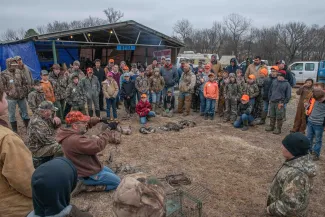
With the use of regulated trapping and the understanding of trap types, landowners can maintain the boundaries they have with wildlife while still promoting a diversity among the landscape.
Managing the land, and the wildlife that inhabits it, is a worthwhile venture for private landowners and public land managers alike. Whether you own half an acre or 150 acres, the implementation of regulated trapping can be vital to managing that property. After a brief history on the evolution of trapping, we will look at where regulated trapping is used by professionals and how private landowners can employ the same tactics in a variety of management strategies. Whatever a landowner may have in mind for their property, regulated trapping is important in achieving those goals.
Trapping has a long and controversial history throughout North America and can be documented in the Oklahoma territory as early as 1719. Overexploitation of the resource and a lack of regulatory guidelines led to a decline in many species of furbearing animals until the 1930s when proper wildlife management began to take shape. Through science-based management decisions and proper enforcement, regulated trapping has become one of the best ways to manage wildlife populations and maintain a balance that is both beneficial to people and wildlife.
Wildlife professionals and research biologists use information gathered from the sportsmen and sportswomen of Oklahoma to monitor population health, distribution, and densities more effectively. Private animal control businesses deal with nuisance complaints and wildlife conflicts in the urban and suburban areas. The United States Department of Agriculture’s Wildlife Services has a focus on resolving wildlife damage conflicts on livestock and property. These professionals have played a large role in maintaining the health and safety of people, wildlife, livestock, and property on a broad scale. The private landowner can fill each of the previously mentioned roles and manage their property just as effectively at the ground level, achieving a multitude of goals by implementing regulated trapping.
Since most of Oklahoma’s land is privately owned, landowners become very important in a statewide wildlife management program. We put up fences and hedgerows to limit access to our property, but these boundaries are meaningless to our state’s abundant wildlife. And when they visit, most everyone enjoys the sight of wildlife when they are out in wide open spaces. There are few who tolerate skunks under the front porch or raccoons in the chicken coop. When boundaries have been crossed, regulated trapping presents itself as a very effective solution.
Livestock producers, from poultry to cattle, can use regulated trapping to reduce the impact that predators can have on their animals and pocketbooks. The focus will shift on what type of predator is needing to be managed depending on the type of livestock you have, what type of depredation measures have already been taken, and your location within the state. Free-range poultry producers will have more variables to consider than pen-raised poultry. A stocker cattle operation will have different concerns than a cow-calf outfit. Crop producers can reduce the amount of live crop damage on their agricultural fields, stored grains/crop loss at their granaries, and field/irrigation damage by administering a program of regulated trapping for problematic species.
Landowners who manage their property for recreation, fishing, or hunting can benefit greatly from regulated trapping on their acreage. Fishing or recreational bodies of water are susceptible to fish predation, impoundment, or infrastructure damage from wildlife. Using regulated trapping as a management tool to reduce or eliminate the monetary cost and labor needed in resolving such issues can be worth the effort for the property owner. Managing a property for big game and upland game bird hunting primarily has a focus on habitat quality and diversity. While this is a necessity, so is managing the predator load that having a quality and diverse habitat brings with it.
It is possible, with the selectivity of trap types and placements, to target individual species that would be key to your management goals. Using an enclosed trigger style trap to target raccoon in an area where nest predation is severe can be extremely beneficial to ground nesting birds while not interfering with dog running activities on the property. Adjusting pan tension for a foot-hold style trap along with proper trap placement and species-specific lures can be very selective for attracting coyotes in an area where white-tailed deer recruitment has been an issue.

The Oklahoma Fur Bearers Alliance is one resource for learning more about regulated trapping techniques.
Homeowners in all areas of Oklahoma who just enjoy nature can find uses for regulated trapping. While we enjoy our vegetable gardens, fruit trees, flower beds and bird feeders there is always some critter out there waiting to enjoy it even more. Live traps, or cage traps, are a style of trap that is easy to set, check, relocate (after obtaining proper permission on the new area), and release problematic wildlife in, and around, your home. These nuisance wildlife species not only can damage your outside spaces, but also inside of your home. With the use of regulated trapping and with an understanding of trap types, the private individual can maintain the boundaries they have with the wildlife while still promoting the diversity among the landscape that we, human and animal, enjoy so much.
There are so many ways that well enforced, regulated trapping can positively impact the landscape around you. Whether you choose to practice these methods yourself, employ a private business or federal agency, or grant access to your property for use by a resident trapper, you can access the benefits of regulated trapping in your surrounding environment. We Oklahomans use our land in a variety of ways, and regulated trapping supports them all.
Learn more about furbearer management and best management practices for trapping from the Association of Fish and Wildlife Agencies.